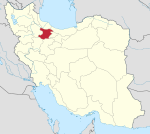Qeshlaq-e Charkhlu
Qeshlaq-e Charkhlu Persian: قشلاق چرخلو | |
|---|---|
Village | |
| Coordinates: 35°48′00″N 49°48′05″E / 35.80000°N 49.80139°E[1] | |
| Country | Iran |
| Province | Qazvin |
| County | Buin Zahra |
| District | Ramand |
| Rural District | Ebrahimabad |
| Population (2016)[2] | |
| • Total | 1,360 |
| Time zone | UTC+3:30 (IRST) |
Qeshlaq-e Charkhlu (Persian: قشلاق چرخلو)[a] is a village in Ebrahimabad Rural District of Ramand District, Buin Zahra County, Qazvin province, Iran.
Demographics
[edit]Population
[edit]At the time of the 2006 National Census, the village's population was 1,180 in 271 households.[4] The following census in 2011 counted 1,286 people in 364 households.[5] The 2016 census measured the population of the village as 1,360 people in 390 households. It was the most populous village in its rural district.[2]
See also
[edit]Notes
[edit]References
[edit]- ^ OpenStreetMap contributors (14 September 2024). "Qeshlaq-e Charkhlu, Buin Zahra County" (Map). OpenStreetMap (in Persian). Retrieved 14 September 2024.
- ^ a b Census of the Islamic Republic of Iran, 1395 (2016): Qazvin Province. amar.org.ir (Report) (in Persian). The Statistical Center of Iran. Archived from the original (Excel) on 30 November 2021. Retrieved 19 December 2022.
- ^ Qeshlaq-e Charkhlu can be found at GEOnet Names Server, at this link, by opening the Advanced Search box, entering "-3080136" in the "Unique Feature Id" form, and clicking on "Search Database".
- ^ Census of the Islamic Republic of Iran, 1385 (2006): Qazvin Province. amar.org.ir (Report) (in Persian). The Statistical Center of Iran. Archived from the original (Excel) on 20 September 2011. Retrieved 25 September 2022.
- ^ Census of the Islamic Republic of Iran, 1390 (2011): Qazvin Province. irandataportal.syr.edu (Report) (in Persian). The Statistical Center of Iran. Archived from the original (Excel) on 19 January 2023. Retrieved 19 December 2022 – via Iran Data Portal, Syracuse University.


 French
French Deutsch
Deutsch
